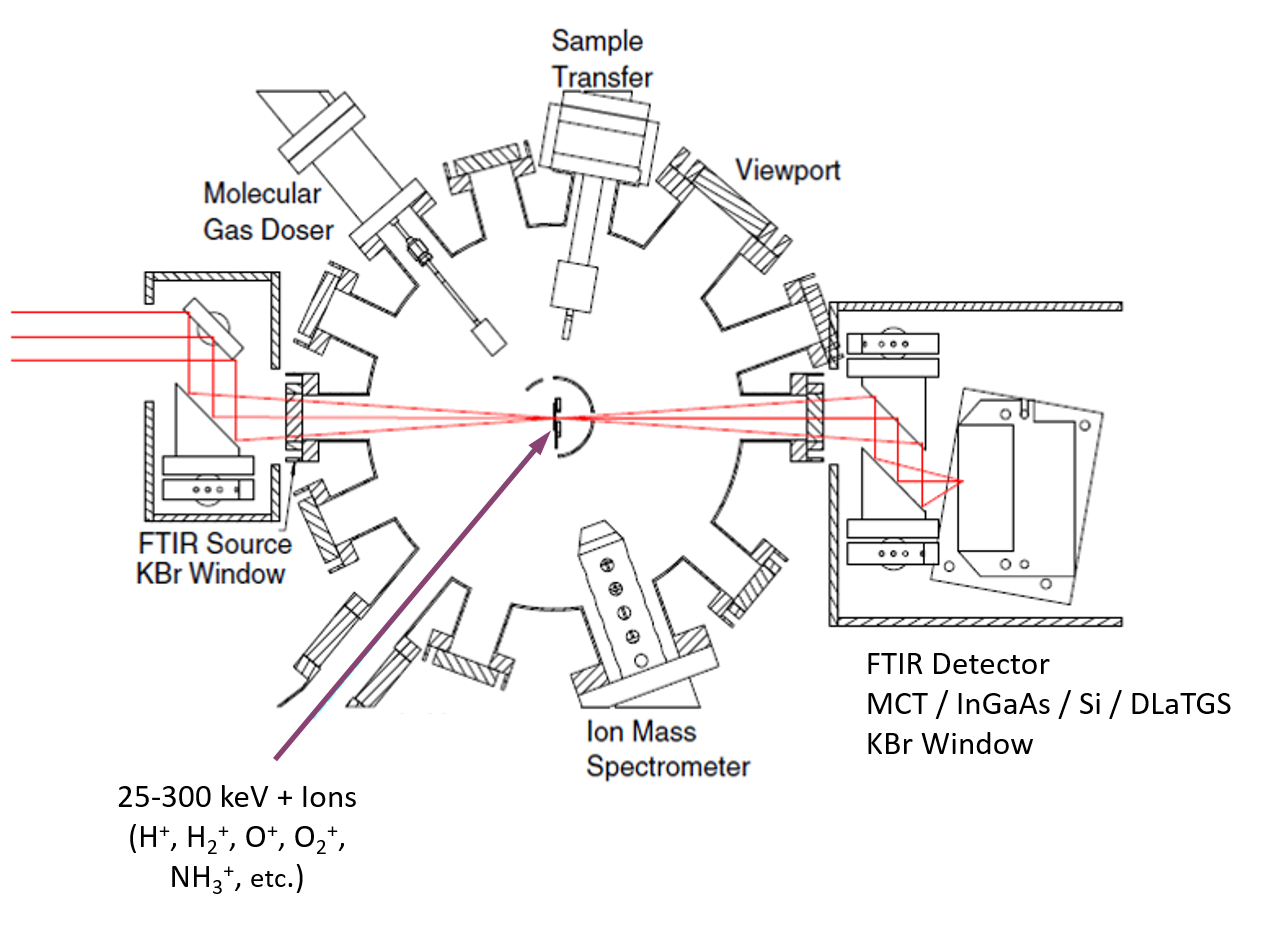ICE Analysis Chamber
ICE: UHV Multi-Technique Cryogenic Analytical Chamber
The solid-phase in ISM and planetary cosmochemistry is of high-importance, as granular surfaces act as substrates for simple and complex molecular species formation by gas-grain chemistry and photolytic / radiolytic reactions, as well as serve as reservoirs for important reactive species in cold clouds.
Available Fall 2024.

ICE chamber laboratory experiments will be performed under ISM/outer solar system conditions (P ~ 10-10 Torr) with temperature control (7–300 K) set or ramped, as appropriate [e.g. Schaible & Baragiola 2014; Raut et al. 2008]. Since in situ mass loss studies using quartz crystal microbalance (QCM) are highly sensitive (< 0.1 ML, 1 ML = 1 × 1015 molecules/cm2) to contaminant deposition, the use of UHV is imperative for low-temperature studies. Ices and ice-mixtures can be deposited in situ via single or dual gas dosers onto a target within a radiation-shielded cryostat. Vapor films are grown on a KBr window for optical transmission studies or the QCM for areal mass-loss measurement which, when combined with UV-Vis interferometry thickness, provides quantitative determination of film porosity/density [Bu, Dukes, & Baragiola, 2016].
Ice films are characterized and quantified via in situ infrared FT-IR transmission or specular reflectance, as required, over 0.8–16 um at 0.5 cm−1 resolution. Mass spectroscopy will identify ejected species, either desorbed or sputtered [e.g. Dukes and Baragiola 2015]. Typically measurements will be isothermal/isobaric as a function of ion flux and fluence, but temperature programmed-desorption / mass-spectroscopy (TPD-MS) analysis at ~0.1 K/min will be done upon completion of irradiation to elucidate species formation/destruction pathways. Additional instrumentation from the GRAINS chamber [e.g. Kelvin Probe] can be added.
UV-Vis Interferometer
A Filmtek 2000 spectrometer (200-900 nm) with dual deuterium / halogen lamps is coupled to the irradiation chamber via optical fiber and UV-grade sapphire lenses and windows. A linear charge-coupled-device (CCD) array (2048 pixels) measures the reflected light intensity as a function of wavelength. Ice film thickness is obtained by fitting the Fresnel equations to the interference pattern from the ice on the reflective gold QCM.
Fourier-Transform Infrared Spectrometer
A Thermo-Nicolet Nexus 670 Fourier-Transform Infrared Spectrometer is coupled to the photolysis/radiolysis UHV chamber via KBr windows and Au-coated focusing optics within a dry-air-purged region. The FTIR with XT-KBr (or Quartz) beam-splitter has both white light halogen (25000 – 5000 cm-1) and infrared Globar (9000 – 50 cm-1) sources, as well as MCT (11700 – 600 cm-1), InGaAs (1200 – 3800 cm-1), Silicon (27000 – 8600 cm-1), and DTGS (12500 – 350 cm-1) detectors sensitive to a total wavelength range of ~ 0.6 – 25 μm with a resolution of 2 cm-1. Incident light intensity can be adjusted via the aperture (1 – 100) at the light source, and the minimum beam spot (aperture = 1) on the sample is ~3 mm in diameter.
Ion (+/-) / Neutral Mass Spectrometer
Hiden Analytical EQS 300 sector-field electrostatic energy analyzer and quadrupole mass spectrometer for neutrals and ions has a range of 1-300 amu, mass resolution of 0.01 amu, an energy filter with range 1–1000 eV and resolution 0.05 eV, and an ionizer with programmable electron energy. It is installed in a differentially-pumped chamber. (Note that an identical instrument has been proposed for the GRAINS chamber).
Gas Doser
Gas doser with micro-capillary array, leak valve, and pumped gas manifold for ice deposition. Both Dual and Single Dosers are available.